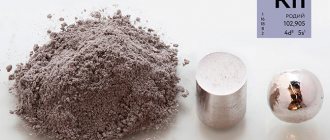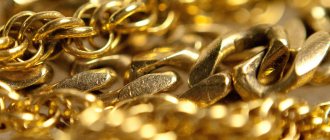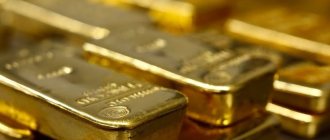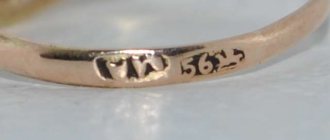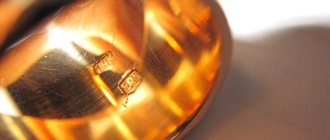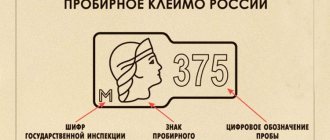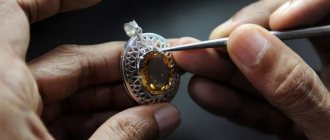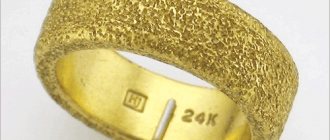You, no doubt, know that jewelry is almost never made of pure gold, since this metal very quickly becomes scratched and loses its beautiful appearance.
In addition, a product made from it can be easily bent with your fingers, and small parts break off and are lost at the slightest damage. To make gold stronger, a ligature is used - a special additive that improves not only the strength, but also the color of the jewelry. Let's talk about what a ligature is in jewelry, what it consists of, and how it changes the properties of gold.
Why do you need a ligature and is it possible to do without it?
In the jewelry industry, the alloy for gold is extremely important - by adding various elements to the alloy, you can achieve significant changes in the characteristics of a gold product, such as strength or appearance. It should be taken into account that only pure metals are used as an additional element, without any impurities. This does not mean that gold can only be mixed with one specific element; the combination of several metals is allowed and quite successfully used. Pure gold is a rather soft and very ductile metal, and such jewelry made from it will be quite difficult to wear without worrying about its safety. This is why a ligature is used - by adding other elements to it, it becomes possible to significantly increase the strength of the product.
Why is metal ligation performed?
The addition of alloy metals in many cases is extremely necessary; they significantly increase wear resistance and also change some characteristics of the main component of the alloy. What properties are affected by the admixture of an auxiliary metal:
- melting point;
- fluidity;
- strength;
- color;
- improvement of intercrystalline structure.
Metal alloy is a process that has a “great future.” Due to the considerable number of components, different alloys can be created. The use of this process has made it possible to obtain new types of alloys that are widely used in various sectors of human activity. Moreover, replacing such alloys with one of the components of their composition is categorically excluded.
What is it?
The amount of pure gold is indicated in the hallmark of the jewelry. There are 4 types of samples: metric, carat, spool and lot. The most popular is metric, consisting of 3 digits: they indicate the amount of gold per 1 kilogram of product mass. For example, fineness 999 means that in one kilogram of the alloy there is only 1 gram of alloy - everything else is pure noble metal. But it is unlikely that you will be able to wear such jewelry successfully, due to the softness of the material. There are several samples:
- 375. the lowest sample, in which 62.5% is ligature. Products with such a hallmark are notable for their low cost, but are significantly stronger and more durable than more expensive jewelry;
- 583, “Soviet” gold. Today, the manufacture of goods from this alloy is not carried out. The share of occurrence of other metals is 41.7%;
- 585. The most popular hallmark is a stamp containing these numbers, which are found on almost every piece of jewelry. Perfectly combines high performance characteristics and excellent appearance. The ligature accounts for 41.5% of the total mass;
- 750 sample. This product accounts for 75% pure metal. Products made in this way are highly expensive, since the composition also includes precious metals;
- 958 standard is practically not used in jewelry. Bullions are usually obtained from it, which are then used in the banking industry.
What components determine color:
- White - 585 gold (ligature: platinum, silver, nickel, palladium) contains a little more than half of the yellow precious substance.
- Red - obtained by adding copper.
- The yellow tint for a noble metal is natural; in such compounds, copper or silver alloy is used.
- Purple decorations are obtained by adding 750-grade aluminum to the material.
- Ruthenium, chromium and rhodium are present in black rings, bracelets or pendants.
- Greenish jewelry uses rubidium and silver alloying additives. These things look luxurious, but are not very durable.
The highest price is for platinum alloys. Nickel analogues are cheaper, but they do not have a pronounced shine. These works are similar to silver ones.
The shade of the decoration depends on what kind of ligature it contains. Metal added singly or a combination of several elements gives the craft originality and uniqueness.
How does the ligature depend on the color of the decoration?
Depending on the elements added to the ligature, the shade of the resulting products also differs: White . Appears as a result of mixing the precious metal with palladium, platinum, manganese or nickel. The composition was considered one of the most popular at the beginning of the last century. Yellow . The shade inherent in a natural noble metal. The alloy contains only copper and silver. Red . Red or royal gold is obtained by adding copper to the base metal. Products made using this method are highly durable. The green tint is obtained by adding silver or rubidium. The greater the amount of silver, the lighter the product will be. But the resulting items are quite fragile, despite their stunning appearance. black product owes its appearance to the presence of rhodium or ruthenium in the alloy. Compounds of chromium and cobalt are used as analogues, after which the surface of the objects is oxidized artificially.
The influence of impurities in gold and silver alloys on the quality of jewelry
In the Russian jewelry industry, alloys produced at a specialized enterprise are rarely used in the production of products, mainly due to the high cost of the metal. Most enterprises prefer to alloy precious metals directly in their production. This imposes certain qualification requirements on the technological personnel of a given enterprise.
As a rule, technologists are well aware of the influence of alloying components on the technological properties of alloys. The influence of microimpurities, according to my observations, is not given due attention. Meanwhile, ignoring this fact often leads to very disastrous consequences in the form of mass defects of products. This article discusses the influence of impurities on the properties of gold and silver alloys.
Let us recall the main impurities of precious metals and their influence on the technological properties of alloys. GOST 30649-99 [1] sets the maximum content of four metal impurities in gold and silver alloys: iron, lead, antimony, bismuth. These elements are found in natural metal.
Lead.
It forms intermetallic compounds with gold and silver, located around the grains of the metal lattice, and embrittles the alloy, making it unsuitable for rolling and bending. Subsequent heating leads to even greater brittleness.
Antimony is also characterized by a similar effect.
and
bismuth
.
Iron.
Due to easy oxidation, iron in gold and silver alloys is present in the form of foreign inclusions. This does not affect the processing of the alloy by pressure, but significantly complicates the machinability of the metal by cutting and during finishing operations.
Of non-metallic impurities, GOST establishes the maximum oxygen
.
The latter is actively absorbed from the atmosphere by molten silver and oxidizes the alloying components of the alloy, mainly copper. The resulting cuprous oxide
causes embrittlement of the alloy. [2,3]
The above-mentioned effects appear already at a content of several hundredths of a percent of these impurities. Naturally, when using recycled metal from reversible waste of an enterprise, harmful impurities are concentrated, their qualitative composition expands due to the introduction of new ones that get into the metal during various technological operations.
Aluminum.
With increasing aluminum concentration, the ductility of alloys increases. This means that aluminum acts as an alloying component and as a deoxidizing agent (cleanses the metal of gases and cuprous oxide). However, as a result of deoxidation, Al2O3 is formed and even at a content of 0.01%, rolled steel has significant defects on the surface.
Tin.
Reduces the strength and hardness of alloys, ductility does not change. When the tin content is more than 0.008%, the surface quality of rolled products deteriorates sharply: swellings and films appear.
Phosphorus
soluble only in copper and has limited solubility in gold and silver. Phosphorus acts as a deoxidizing agent, increasing the ductility of the alloy. The hardness of the alloy is minimal, the drawing depth and the number of bends are maximum. With a content of no more than 0.08%, a good surface of the rolled product is maintained, however, the structure of the alloy deteriorates.
Sulfur
, dissolving in melts of gold and silver, copper, does not form solid solutions with these metals. Therefore, when the alloy solidifies, the ingot “boils” already at a sulfur content of 0.02%, is characterized by the presence of gas porosity and is unsuitable for rolling. With a sulfur content of 0.004-0.01%, the metal's mechanical characteristics are close to alloys alloyed with aluminum: strength increases while ductility decreases. Sulfur enters gold and silver alloys during melting and annealing under a layer of charcoal containing sulfur from an atmosphere polluted by industrial gases, with sulfuric acid residues after etching of products.
Particular attention should be paid to silicon
. All studies of the Soviet period claim that silicon is an extremely harmful impurity, since, not dissolving in gold and silver, but only in copper, it significantly embrittles alloys, reducing the drawing depth and the number of bends [4]. They recommended limiting the silicon content in alloys to 0.003%. However, in recent years, most enterprises in the Russian jewelry industry have begun to use ready-made imported master alloys for alloying. This turned out to be much easier and cheaper than the proven “old-fashioned” method of preparing an alloy from pure metals. It turned out that these alloys contain silicon in quantities exceeding the previously established limit for its content. It turned out that in three- or more-component systems, silicon dissolves somewhat better than in pure metals, increasing, as shown by X-ray diffraction analysis, the perimeter of the crystal lattice of the solid solution. For a more detailed study of the issue of the influence of silicon on the properties of gold alloys, the author refers the reader to thorough works [5,6]. Note that in this case, silicon should be considered not an impurity, but a dopant component according to [7]. The introduction of silicon into alloys gave two noticeable advantages: a decrease in the oxidizing ability of the alloy and a decrease in the thickness of the enriched layer on the surface of products, which made it possible to eliminate the very labor-intensive and environmentally harmful operation of anodic etching of castings. Now it’s quite possible to get by with magnetic tumbling.
However, this good idea, rushing through the potholes and potholes of Russian business, gradually began to turn into something extremely indigestible. Most Russian enterprises purchase master alloy from suppliers operating in Russia. And relationships with them are basically played out according to the scenario: “Zoya Ivanovna, accept the marriage from these citizens and give them a new one.”
Let me explain my point. The fact is that batches of alloys of the same brand, when put into production, sometimes differ sharply in their technological properties, leading to instability of the technological process and giving a lot of worries to the technologist: how can he guess ways to adjust the technical process in order to produce a high-quality product, and Do not waste metal.
The manufacturer usually does not inform the customer about the composition of alloys, hiding behind the notorious “know-how”. However, in our world of “interplanetary communications” and high chemical technologies, known even in technologically backward Russia, this “know-how” will only survive until the first competent chemist. However, some ligature suppliers partially inform their clients of the composition of the ligatures they use. That's how this sign came to me.
Why is the decoration yellow or white in one test?
The white tint of the product is due to the presence of the following metals: platinum, palladium or silver in the alloy. The most expensive alloy is mixed with platinum - not all consumers can afford such jewelry. Compositions with nickel are more accessible, and they can be identified by their less bright shine, vaguely reminiscent of jewelry silver. But it is worth knowing that products made from this alloy negatively affect the health of the owner, often causing allergies. Adding only 1/10 of platinum often gives the composition shine and a distinctive white color, significantly increasing strength and increasing the material’s resistance to chemical attack. 585 standard contains a little more than half of gold, the rest consists of silver or platinum, which ensures the white color of the product. Impurities of palladium or nickel give a barely noticeable yellowish tint. To obtain a pronounced white color, the composition is additionally coated with a layer of rhodium, an element belonging to the platinum group of metals, which gives the product high resistance to mechanical stress. The cost of this metal exceeds the cost of gold, and for this reason the value of such jewelry is comparable to the value of objects made of pure precious metal. Also, such decorations are absolutely harmless to health.
Understanding platinum
Platinum is a precious metal that visually resembles silver. However, this is only the first similarity, which will not be difficult to distinguish. Silver has a warm tint, while platinum is rewarded with a noble white color. Comparing platinum with white gold is not entirely correct, because in fact, white gold has a quite noticeable warm undertone, which is neutralized by the top protective coating of rhodium or ruthenium. Yes, it is possible to alloy white gold without a pronounced warm tint, but in practice this alloy is practically not used.
The minimum purity of platinum does not fall below 850, although the metal usually has an even higher value. The favorite standard of BENSES jewelers is 950 platinum.
Platinum products are more expensive than gold, but few people know why. The opinion has been established that gold is simply cheaper, but in reality this is not entirely true. The initial cost of pure metals per gram is approximately the same, sometimes even platinum can be cheaper. The difference begins to be felt the moment the jewelers get to work.
The difference between white gold and silver jewelry
Despite the external similarity, there are several differences by which you can find out whether the product is silver or gold
- Try. For silver jewelry it is 925. White gold is found in stores only 585 or 750.
- Gold items are significantly harder than silver items.
- Silver does not shine as brightly as white gold.
A ligature in gold allows you to completely change the properties of the metal, making it possible to obtain real masterpieces. It is thanks to the chemical properties of various alloys that today everyone can find jewelry to suit their taste.
Most popular alloys
Aluminum and copper alloys are often used in foundries as effective deoxidizing agents because they have unique and beneficial characteristics that aid in the direct casting of the alloy.
Foundry production can easily do without these additives, but this will reduce the quality of the metal, increase the consumption of raw materials and cause inconvenience during the casting process itself. Therefore, the use of alloy metals becomes profitable and justified due to a noticeable reduction in the cost of production and a reduction in the final cost per unit of product.
On display, gold items have different shades. For example, if the earring has a purple tint, it contains aluminum and gold. If it is greenish in color, zinc has been added.
Excerpt characterizing Ligature (metallurgy)
“They told me that you ordered a pawn,” she said, out of breath (she was apparently running), “and I really wanted to talk to you alone.” God knows how long we will be separated again. Aren't you angry that I came? “You have changed a lot, Andryusha,” she added, as if to explain such a question. She smiled, pronouncing the word “Andryusha”. Apparently, it was strange for her to think that this stern, handsome man was the same Andryusha, a thin, playful boy, a childhood friend. -Where is Lise? – he asked, only answering her question with a smile. “She was so tired that she fell asleep in my room on the sofa. Ax, Andre! Que! tresor de femme vous avez, [Ax, Andrey! What a treasure your wife is,” she said, sitting down on the sofa opposite her brother. “She’s a perfect child, such a sweet, cheerful child.” I loved her so much. Prince Andrei was silent, but the princess noticed the ironic and contemptuous expression that appeared on his face. – But one must be lenient towards small weaknesses; who doesn't have them, Andre! Don't forget that she was brought up and grew up in the world. And then her situation is no longer rosy. You have to put yourself in everyone's position. Tout comprendre, c'est tout pardonner. [Whoever understands everything will forgive everything.] Think about what it must be like for her, poor thing, after the life to which she is accustomed, to part with her husband and remain alone in the village and in her situation? It's very hard. Prince Andrei smiled, looking at his sister, as we smile when listening to people whom we think we see right through. “You live in a village and don’t find this life terrible,” he said.
In what areas is ligature used?
The admixture is aimed at improving the physical and chemical characteristics of precious metals. A metal additive is introduced when cooking the base, making it refractory. In the process of adding the alloy, experts take into account the loss of metal that occurs during melting. This means that the share of impurities directly depends on the volume of the precious metal after the “waste”. Due to their physical properties, alloys are used in many fields:
- Jewelry craftsmanship. All GOST alloys are represented by alloyed metals. The fineness with the minimum allowable amount of gold is 350, which contains only 35% of it, and is not used for jewelry. However, you can find jewelry of 375 standard. The most popular is 585 red gold. The alloy includes 58.5% precious metal, 20% copper and other impurities. Such products are distinguished by a scarlet tone. You can work with scrap gold in the jewelry industry thanks to a ligature.
- Musical instruments. Ligatures are used in saxophones and other instruments. There is an impurity on the part that is attached to the mouthpiece. The precious alloy part reduces air loss, making the sound especially colorful and drawn-out.
- Dentistry. There is a special ligature alloy for dental braces, which is used to bind the metal and plastic parts attached to the teeth.
- Medicine. Ligature thread is used by surgeons to ligate severely damaged vessels.
- Production of equipment. A strong ligature is used to make many modern gadgets. The electrical connector, microcircuits, and contacts are covered with ligature material.
